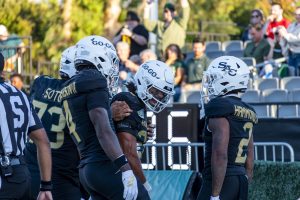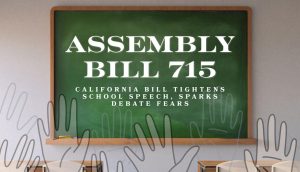Computer labs will charge for printing next semester
September 13, 2000
Beginning next semester, Sacramento State students will pay to use the printers in the campus computer labs.
Students will be allowed 100 free pages each semester, and every page over that limit will cost five cents. Pages and fees will be tracked on the OneCard, said Patricia Larsen, Library dean and chair of the Student Computer Printing Work Group sub-committee.
“This change will be implemented in 41 labs, including four stations in the library,” Larsen said.
The sub-committee, which includes various staff and faculty members, put together a proposal regarding printing fees and sent it to the Council on Information Technology. COIT approved the proposal, Larsen said, but the Student Fee Commission imposed the free 100 pages before agreeing to the proposal.
President Donald Gerth approved the proposal, and the testing phase of the program is scheduled to begin sometime next month when the necessary equipment and software arrive, said Information Technology Consultant Scott McGown.
“We don?t anticipate any problems,” he said.
Although a few details have yet to be worked out, McGown, who is also a member of the sub-committee, was able to explain how the system would work.
“When the student selects the print option on the computer, a window will pop up and prompt the student to create a password for the print job,” McGown explained. “The student will go to the print station, select the print job and enter the password.”
The password will offer the student security so that another person cannot delete the jobs. Once the password is entered, the student will see the total fee for the print job, insert his OneCard to pay the fee and collect his print job when it is completed.
The program will be similar to the photocopier system that is currently in place on campus. McGown said that the sub-committee set several goals when it began examining the print fee issue.
“We wanted to reduce the exponential growth of print costs, make printing more accessible, eliminate the current print periods and implement the system in all areas at the same time,” he said.
Currently, students may only print during the print periods that occur every half hour. The new system will allow students to print immediately.
McGown said the biggest obstacle to the program would be the change. However, he said that other schools have successfully implemented similar programs.
“In 1998, we printed 1.3 million pages in the computer labs,” McGown said.
This number does not include the library or the rest of the campus. Furthermore, in 1999, 2.5 million pages were printed in the labs. This number exceeded the estimated 2 million pages, McGown said.
As the rate of printing goes up, the costs will also rise. Paper and toner cost the university approximately $100,000 each year. Larsen said the software and server needed to run the new program will be a one-time cost of $55,000.
“We don?t know if it will really save a lot of money,” she said. “The 100 free copies is a big question mark.”
However, McGown does think that the program will cut down the amount of printing. “In other schools that have similar programs, printing has gone down 50 to 80 percent,” he said. From an environmental standpoint, this program will be an asset to the campus.
“We encourage people to bookmark Web sites and email articles to themselves, rather than print them out,” Larsen said. “We?re asking students to stop and think about what they?re doing.”
Beginning next semester, Sacramento State students will pay to use the printers in the campus computer labs.
Students will be allowed 100 free pages each semester, and every page over that limit will cost five cents. Pages and fees will be tracked on the OneCard, said Patricia Larsen, Library dean and chair of the Student Computer Printing Work Group sub-committee.
“This change will be implemented in 41 labs, including four stations in the library,” Larsen said.
The sub-committee, which includes various staff and faculty members, put together a proposal regarding printing fees and sent it to the Council on Information Technology. COIT approved the proposal, Larsen said, but the Student Fee Commission imposed the free 100 pages before agreeing to the proposal.
President Donald Gerth approved the proposal, and the testing phase of the program is scheduled to begin sometime next month when the necessary equipment and software arrive, said Information Technology Consultant Scott McGown.
“We don?t anticipate any problems,” he said.
Although a few details have yet to be worked out, McGown, who is also a member of the sub-committee, was able to explain how the system would work.
“When the student selects the print option on the computer, a window will pop up and prompt the student to create a password for the print job,” McGown explained. “The student will go to the print station, select the print job and enter the password.”
The password will offer the student security so that another person cannot delete the jobs. Once the password is entered, the student will see the total fee for the print job, insert his OneCard to pay the fee and collect his print job when it is completed.
The program will be similar to the photocopier system that is currently in place on campus. McGown said that the sub-committee set several goals when it began examining the print fee issue.
“We wanted to reduce the exponential growth of print costs, make printing more accessible, eliminate the current print periods and implement the system in all areas at the same time,” he said.
Currently, students may only print during the print periods that occur every half hour. The new system will allow students to print immediately.
McGown said the biggest obstacle to the program would be the change. However, he said that other schools have successfully implemented similar programs.
“In 1998, we printed 1.3 million pages in the computer labs,” McGown said.
This number does not include the library or the rest of the campus. Furthermore, in 1999, 2.5 million pages were printed in the labs. This number exceeded the estimated 2 million pages, McGown said.
As the rate of printing goes up, the costs will also rise. Paper and toner cost the university approximately $100,000 each year. Larsen said the software and server needed to run the new program will be a one-time cost of $55,000.
“We don?t know if it will really save a lot of money,” she said. “The 100 free copies is a big question mark.”
However, McGown does think that the program will cut down the amount of printing. “In other schools that have similar programs, printing has gone down 50 to 80 percent,” he said. From an environmental standpoint, this program will be an asset to the campus.
“We encourage people to bookmark Web sites and email articles to themselves, rather than print them out,” Larsen said. “We?re asking students to stop and think about what they?re doing.”
























































































































